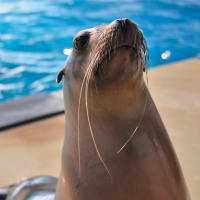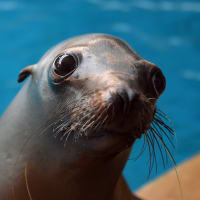
California Sea Lions
Size
Males: average around 770 lbs and 8 ft in length. Females: average 176-220 lbs and up to 6 ft in length

Diet
Octopus, squid, herring, mackerel, rockfish, shellfish, cod, flounder, sculpin, and salmon

Habitat
Rocky/sandy coastal islands and mainland shorelines. Preferred haul out is on sandy beaches, but will use marina docks, boat docks, jetties, and buoys

Range
West Coast of the U.S. As far north as Vancouver, BC and as far south as Baja, CA in Mexico
Conservation Status
Least Concern
Near Threatened
Vulnerable
Endangered
Critical
Extinct in Wild
Extinct
Physical Description
California sea lions are “eared seals” with long narrow snouts that give them their characteristic dog-like face. They have large front flippers that they use to walk on land. They can also rotate their hind flippers to help with onshore locomotion.
There are several ways you can tell the difference between male and female California sea lions. First is their coloring. Males’ fur is chocolate brown, while females’ fur is a lighter, golden brown. Second is their size. Adult males can weigh four times as much as females. Third, male California sea lions develop a bony bump, called a sagittal crest, on the top of their skull. The sagittal crest starts growing when the males are about 4 years old and is fully developed by the time they are 7 years old.
Behavior & Diet
California sea lions are known for their intelligence, playfulness, and noisy barking. They are social on land and in the water. They are very vocal, and bark at each other to communicate. Just like humans, each has a unique voice. Mother sea lions can identify their pup’s barking from a group of hundreds of others. Sea lions also each have a unique smell. Once the mom finds her pup in the group, she smells it as a final check to make sure it’s hers.
California sea lions are faster than any other sea lion or seal in the world, with a top speed of 25-30 mph. In the water, California sea lions are graceful and acrobatic swimmers that can dive to depths of 900 feet. They will sometimes leap out of the water in a behavior called “porpoising.”
One common behavior—called “rafting”—can make a sea lion look like it’s caught in a net. A rafting sea lion holds its flippers above the water for a long time, motionless, to rest and regulate its body temperature.
Lifespan & Reproduction
The life expectancy of California sea lions is 20-30 years.
The breeding season for California sea lions lasts from June to early August. Males will establish a breeding territory that includes up to 14 females, and will aggressively defend this territory with physical displays and vocalizations.
California sea lions nurse their pups for up to a year. During this period, the mother sea lion will nurse for 1 -2 days, and then will leave her pup to feed for several days. The pups are left alone while the mother is out feeding.
At Mystic Aquarium
Visitors to Mystic Aquarium can visit our California sea lions at the Foxwoods Marine Theater. There is an expansive underwater viewing area in the Main Gallery, and several shows with our sea lions and their trainers throughout the day.
While we are proud that educational information on sea lions is delivered with your entertainment in mind, the behaviors exhibited by the animals in the show are an important part of animal care and enrichment. All training is based on positive reinforcement, meaning that no sea lion is ever punished if he or she doesn’t exhibit a certain behavior. Their training includes behaviors they would do in the wild as well as behaviors that help them become accustomed to health checks, such as opening their mouths wide so the veterinary staff can examine their teeth.
Meet our California sea lions

Clara

Sakari

Pyp

Cali

Maia

Clara
Clara was rescued by Santa Barbara Marine Mammal Center after she stranded off the coast of the Channel Islands. She is named after the street that runs alongside Mystic Aquarium, Clara Drive. She knows the most vocalizations of all the California sea lions, and is sassy and fiercely independent. She enjoys when the trainers give her noogies and likes to play in the water jets. She has the lightest coloring of all the California sea lions at the aquarium, which is a good way to distinguish her from the others.

Sakari
Sakari arrived at Mystic Aquarium in May 2009, after getting stranded off the coast of California. She was rescued and rehabilitated by SeaWorld San Diego before her transfer to Mystic. You can recognize Sakari by the two light spots below her chin and four dark spots on her back at the base of her spine. Her face is streamlined with all long dark vibrissae (whiskers) except for one, thick, white whisker on the left side of her face.
Sakari is a go-getter who knows more than 170 behaviors! She loves to play with jello and “kelp” (strips from the car wash) and having her trainers slide her into the pool on her belly.

Pyp
Pyp is the largest of the California sea lions at Mystic Aquarium. She has a narrow, triangle-shaped snout. Pyp was rescued by the Santa Barbara Marine Mammal Center after she stranded on the California coast.
Pyp has a laid back, quirky personality. When she vocalizes, she sounds like a goat. She loves to cuddle with Sakari and play with ice cubes. She also likes to interact with humans and is the California sea lion who most often participates in the Animal Encounters program.

Cali
Named after the state she arrived from (California), Cali came to Mystic Aquarium in 2009 after being rescued and rehabilitated by SeaWorld San Diego. Cali has long vibrissae (whiskers) and large, prominent eyes.
Cali is sassy, acts like she’s the queen, and is a picky eater. She will NOT eat anchovies or lake smelts. In her free time, she enjoys pushing basketballs around the pool with her nose.

Maia
Maia was rescued by the Santa Barbara Marine Mammal Center after she stranded off the coast of California. She has a short, round snout, a bulldog nose, and expressive googly eyes. Maia is shy and sweet and wants to be a part of the “in crowd,” doing whatever Sakari and Cali do. Of all the California sea lions, Maia’s on-cue vocals are the quietest, but she’s a hard worker and always tries her best. She loves getting chin rubs from the trainers and she has great dance moves.
California Sea Lion Quick Facts
What is a California sea lions habitat?
California sea lions frequent rocky and sandy beaches of coastal islands and mainland shorelines.
Where do they live?
As far north as British Columbia, Canada to as far south as Baja California and Mexico.
What are their threats in the wild?
Because they are often found at marinas, boat docks and jetties, the largest threat posed to California sea lions are human interaction injuries like entanglement, harassment and pollution.
Meet our Sea Lions!
Explore a variety of up-close encounter experiences with our California sea lions!


